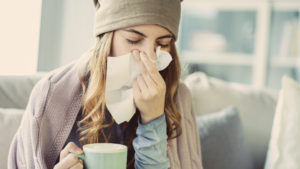
Temperatures have been dropping. You may have even woken up to a slight dusting of snow this morning. Believe it or not, the cooler air could boost your risk for catching a flu or other viruses.
The cold fall and winter air are notoriously dry. But it doesn’t stop there. To stay comfortable at home, we turn on radiators, pump up the furnace, or sit by the fire. All of these tactics suck moisture from the air to create a dry environment.
You may notice the dryness on your skin. Perhaps your mouth is parched when you wake up.
You are far less likely to notice the virus and bacteria living on surfaces throughout your home and the places you visit.
Dry indoor air can be far worse for you than dry skin. It may encourage the survival of more bacteria and viruses in the air and on surfaces, hamper the ability of your nose and lungs to expel viruses, as well as potentially inhibiting immune response.
Research has shown that adequately humidified elementary school classrooms can cut flu-related absences by more than 65%. Some experts believe that proper humidification could dramatically decrease flu rates and protect humans.
But can a room be too humid? It sure can. When it’s too humid, you run the risk of creating an ideal environment for mold spores. Finding the right balance for optimal immune health is essential.
Studies suggest maintaining a level of 40-60% indoor relative humidity may help kill viruses and bacteria, thereby having protective qualities for humans.
If flu virus can’t live on your high touch surfaces, it’s far less likely you become infected.
Of course, humidity isn’t the only factor that effects flu risk. Other ways to reduce the risk include:
- Washing hands when coming indoors or after touching high-contact surfaces
- Getting a flu shot
- Cleaning/disinfecting high touch surfaces
It’s highly advised to get a flu shot this season as the COVID-19 pandemic continues. Anything you can do to give your immune system a boost can be of significant benefit.